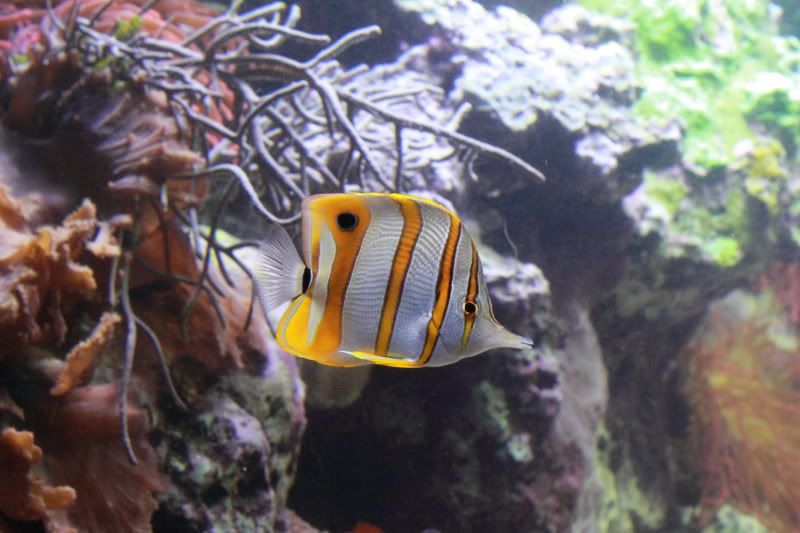You are using an out of date browser. It may not display this or other websites correctly.
You should upgrade or use an alternative browser.
You should upgrade or use an alternative browser.
So, how is it done??
- Thread starter P.Olsen
- Start date
Smitty
Premium member
I couldn't really help you much...I use my blackberry phone camera...which is pretty good to me I guess. Someone once told me though to not stand too close to the glass, because it distorts the pic somehow...I've also learned that shooting at an angle helps with the glare and hazy look.
misenplace101
New member
Using a faster shutter speed will capture the fish in action. Shooting straight into glass with flash will cause reflection/glare. A macro lens will help with closeup shots. As for color...try doing a white balance on the camera and this should help.
misenplace101
New member
To let more light in open up the appeture on the lens also. I think it call the f stop.
loco-phillya
New member
picture help
youll probobly never get a great pic from a point and shoot..
here are some tips that may help..
no algae on glass
close to glass
shield with hand
no flash..
most important but you may not be able to do--
med high f stop 140
med apperture.. 5.6
400-asa
I use a nikon DSLR..check my pics..
youll probobly never get a great pic from a point and shoot..
here are some tips that may help..
no algae on glass
close to glass
shield with hand
no flash..
most important but you may not be able to do--
med high f stop 140
med apperture.. 5.6
400-asa
I use a nikon DSLR..check my pics..
loco-phillya
New member
one more note
one more thing...lighting matters..pics in VHO tend to suck.. Floros suck..
metals and leds are better.. if you have these lights you will see everything turns brown
one more thing...lighting matters..pics in VHO tend to suck.. Floros suck..
metals and leds are better.. if you have these lights you will see everything turns brown
scotty
Member
tripod is moot point, i take mine with my droid 1, and i have to literally put it on the glass to get the non blurry pics. I wish i had a decent camera, maybe i will one day....
I think most of the people that are pro picture people modify the pictures with software to get them looking the most normal colors they can.
I think most of the people that are pro picture people modify the pictures with software to get them looking the most normal colors they can.
triggerfish
New member
sorry to go of topic but does everyone laugh for a minute everytime you see scottys avatar? or is it just me?
i'm still laughing
i'm still laughing
triggerfish
New member
i love that movie
WeePee
New member
tripod is really only needed for a longer exposure rate or slow shutter speed.
took these at the Shedd a while ago


n this was from my old tank

would be nice but my glass was super dirty.
using a Canon T1i, with the basic 18-50mm kit lens.
i really do need a macro, but its the last thing on my budget of stocking my new tank, buying my new car, getting more lenses.
took these at the Shedd a while ago


n this was from my old tank

would be nice but my glass was super dirty.
using a Canon T1i, with the basic 18-50mm kit lens.
i really do need a macro, but its the last thing on my budget of stocking my new tank, buying my new car, getting more lenses.
Tangency
New member
To let more light in open up the appeture on the lens also. I think it call the f stop.
Yes, your aperture determines the amount of light that reaches the camera's sensor. Your aperture also controls the depth of field. If you want a larger depth of field (everything in focus), you will want to increase your aperture to a higher number f/8, f/11, f/16+ If you wish to single out a detail and have a shallow background (blurred) you can do this by opening up your lens f/1.6, f/2.8, f/4
Shutter speed works in conjunction with your aperture. The longer the shutter speed the more blurred movement will become. If you can manually adjust your shutter speed, I recommend not using anything lower than 1/60 of a sec with out a tripod as it will blurred.
You generally will want to use the lowest ISO setting your camera will allow. ISO in digital cameras is yet another means to control the sensors sensitivity to light. This is done but at the cost of noise/fuzz in your photos. The lower your ISO in a good-fair environment will help keep your photos sharp. The lower your ISO is in a low light situation the more noise you will have in your photo. You can keep your ISO (noise level) lower by using a tripod.
A tripod is a great tool. I consider it an essential tool for any photo, and especially if the subject matter is one or all of: water, lighting, macro shots ...which aquariums frequently are. Tripods force you to work slower and think about composition. They will also allow you to have longer shutter times and allow for bracketing. If a tripod is either not in the budget or interest you can also use the cameras built in timer and place the camera body on a stable surface. This will allow for longer exposure times without being blurred.
A flash is another great tool. I don't recommend firing a flash straight into a piece of glass but if you can point your flash and bounce the bounce the light you will be able to bring out some great highlights and eliminate harsh shadows. If you have a basic flash and can not "bounce the light" I recommend trying to diffuse it. Google "snoot" or "diffuser".
Yet another means of reflection control is positioning your lens as close to the glass as possible. Sometimes even a cheap rubber gasket between the glass and your lens for a "seal" will help control both unwanted reflections and light.
Composition is also a vast topic and practice will vastly improve all your photos. Try to use: rule of thirds, golden section rule, balancing elements, cropping, depth and framing until you understand when it is important to break the rules. I recommend also having a colored background. It will help emphasize your subject. Use a dark background for taking a picture of a light object, or, vise-versa (to clarify, this does not necessarily mean aquarium background color... this means background of the framed photo). Lastly, leave a space in a shot in front of an actually or potentially moving fish/subject and let the subject move into place.
SkunkerX
Well-known member
I found that with my camera anyway it takes better pictures when I move back and zoom in, if I am too close to the glass it won't focus even when the glass has no algae on it and if you want to use flash take the picture from an angle and the flash won't be a problem. "flash is only a problem if you are looking straight into the glass" I think a tri-pod would be good for things that are not moving around "like corals" unless you can get the fish to sit still too oh ya btw I have a canon S2IS powershot 5.0 megapixel its about 4 or 5 years old but still takes great pics.

